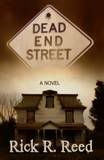Dead End Street / Rick R. Reed
 Amber Quill Press / October 2008
Amber Quill Press / October 2008
Reviewed by: Vince A. Liaguno
Rick Reed has got to be one of the busiest guys working in dark genre fiction right now. 2008, in particular, was a banner year for the dark scribe, with the publication of four novels — Deadly Vision, High Risk, Orientation, and now Dead End Street. Someone take this man on vacation!
With Dead End Street, Reed enters the burgeoning young adult market. Those familiar with Reed’s work – and those acquainted with his colorful blog postings – may at first scrunch their face at the idea and wonder how the oft titillating writer manages to pull this one off. But he does, effectively and suitably for the intended audience.
Dead End Street is a delightful haunted house story, framed by an effective use of the story-within-a-story narrative. Peter, Marlene, Erin, Roy, and David are imaginative eighth-graders from a small Ohio River town whose latest idea is the formation of a storytelling club, the Halloween Horror Club. The idea is simple: each member tells the most horrifying tale they can come up with and the scariest wins. The idea is initially knocked by the group, but Peter, who wears coke-bottle glasses and has been the imagination behind many of the group’s various clubs over the years, offers a unique twist: the stories will be told at the infamous Tuttle house, an abandoned residence on a wooded dead-end street that was once sight to an unsolved triple homicide.
Despite a few misgivings among the group, the teens’ curiosity in the macabre wins out and the club convenes the following week. Peter goes first, with his reimagining of the Tuttle mythos, one in which Paul Tuttle – the teenage son who went missing after the brutal slayings of his parents and young sister – is the victim of demonic possession after watching The Exorcist.
As each of the teens try to top each preceding story with their own tale of terror, the group begins to suspect that they’re not alone in the house. A creaking floorboard here, a mournful cry there, and the teens are suitably spooked as it’s revealed that a mysterious interloper watches and listens from the shadows of the house. Has Paul Tuttle returned to the scene of his alleged crimes to claim more victims? Do the ghosts of the Tuttle family haunt the house on the end of Acton Road? When one of their own stumbles into trouble trying to find out just what – or whom – haunts the Tuttle house, the group must summon its courage to save their friend and confront their own fears in the process.
The teens’ stories work as short, stand-alone tales within the novel and run the gamut of topics and themes —twin sisters lost in the snowy woods with a faceless terror, a werewolf dad for whom the full moon brings the ultimate tragic irony, a late-night driver on a road to nowhere, and a horror-obsessed teenage boy who enjoys scaring people (literally) to death. The stories work well here as campfire tales and help to bring insight into Reed’s teen cast of characters, even if some of the language choices border on precocious at times (“pince-nez glasses” or “The evening was placid.”).
Reed has proven himself time and time again at crafting solid stories in which the suspense ratchets up exponentially with each passing chapter. Dead End Street, even within the confines of its YA limitations, is no exception. The relatively short novel builds to an action-packed finale in which the teens run afoul of the house’s mysterious inhabitant, with Reed twisting and turning the story line just enough so that the reader is kept enjoyably off balance and surprised along the way.
Void of profanity and sexual content but brimming with just enough violence to appeal to teens without putting vigilant parents off, Dead End Street is a perfect YA horror experience for young readers. Adults familiar with Reed’s work and wanting to relive the nostalgia of their Goosebumps or Phyllis Whitney early reading experiences might also want to visit the Tuttle house.
Purchase Dead End Street by Rick R. Reed.



